Introduction to Osiris and Ancient Egyptian Mythology

In ancient Egyptian mythology, Osiris was one of the most prominent and revered gods. As the god of the afterlife, fertility, and resurrection, Osiris played a vital role in the belief system and religious practices of ancient Egypt. Understanding Osiris and the mythology surrounding him provides a fascinating insight into the complexities of ancient Egyptian culture.
Ancient Egyptian mythology is a rich tapestry of gods, goddesses, and mythical beings, each with their unique stories and attributes. The religion of ancient Egypt was highly polytheistic, with a pantheon of gods that governed every aspect of human life and the natural world. Within this vast pantheon, Osiris stood as one of the most significant figures.
Osiris was believed to be the son of the sky goddess Nut and the earth god Geb, making him a member of the ruling divine family. He was married to his sister Isis, and together they reigned as king and queen of Egypt. Osiris was known for his role as the judge of the dead, overseeing the weighing of the heart ceremony to determine the fate of souls in the afterlife. This responsibility solidified his connection to death, resurrection, and the cycles of life and rebirth.
The mythology of Osiris revolves around his tragic demise. According to ancient Egyptian legend, Osiris was murdered by his jealous brother Set. Set dismembered Osiris and scattered his body parts across Egypt. Devastated by the loss of her husband, Isis embarked on a quest to reassemble his body and bring him back to life. Through her dedication and magical abilities, Isis successfully resurrected Osiris, who became the lord of the afterlife.
Osiris became a symbol of hope and eternal life for the ancient Egyptians. He represented the concept of resurrection and the belief that death was not the end, but rather a gateway to another realm. This belief influenced funerary practices, burial rituals, and the construction of grand tombs and monuments, such as the pyramids, which were intended to ensure a smooth transition to the afterlife.
The mythology of Osiris also played a significant role in the annual flooding of the Nile River, which was crucial for the fertility and prosperity of ancient Egypt. It was believed that Osiris controlled the flooding, which brought rich nutrients to the soil and supported bountiful harvests. This connection between Osiris, fertility, and the cycles of nature reinforced his status as a vital figure in ancient Egyptian society.
In conclusion, the mythology of Osiris provides a captivating glimpse into the religious beliefs and cultural practices of ancient Egypt. As the god of the afterlife and resurrection, Osiris held a prominent place in the Egyptian pantheon and influenced various aspects of daily life. His story of death and rebirth, along with his role in the cycles of nature, highlighted the ancient Egyptians' beliefs in the continuity of life and the importance of the afterlife.
The Origins and Family of Osiris

Osiris, one of the most prominent gods in ancient Egyptian mythology, has an intriguing and complex origin story. He is believed to be the son of the sky goddess Nut and the earth god Geb, making him a member of the Ennead, the group of nine deities worshipped in Heliopolis. Osiris was not only a god but also a pharaoh and the ruler of the underworld.
According to mythological accounts, Osiris was born along with his siblings, Horus the Elder, Seth, Isis, and Nephthys. Initially, all the siblings lived in harmony, but it wasn't long before jealousy and conflict emerged.
Osiris eventually became the king of Egypt and married his sister Isis, who played a crucial role in his story. Together, they ruled over the land, teaching the people civilization and establishing laws. Their reign was marked by prosperity and abundance.
However, Osiris's brother Seth grew envious of his success and coveted his throne. In a treacherous act, Seth plotted Osiris's demise. He tricked Osiris into entering a beautifully crafted sarcophagus, which he then sealed shut and threw into the Nile River.
Devastated by the loss of her husband, Isis set out on a quest to find his body and give him a proper burial. She scoured the land tirelessly, collecting the scattered parts of Osiris's body, reconstructing it, and using her magic to bring him briefly back to life.
The story of Osiris's death and resurrection symbolizes the cyclical nature of life and death in Egyptian mythology. It represents rebirth and renewal, depicting the eternal cycle of the seasons and the cycle of birth and death. Osiris's role as the ruler of the underworld further emphasizes this connection to the afterlife.
In addition to his immediate family, Osiris is often associated with the god Horus, his son from his relationship with Isis. Horus was conceived after Osiris's death, and he sought to avenge his father's murder and reclaim his throne from Seth. This ongoing battle between Horus and Seth represents the perpetual struggle between good and evil, order and chaos.
The mythology surrounding Osiris and his family continues to captivate scholars and enthusiasts alike. His story serves as a reminder of the rich and intricate belief system of the ancient Egyptians, highlighting the importance of family, justice, and the eternal cycle of life and death.
The Role and Significance of Osiris in Ancient Egyptian Society
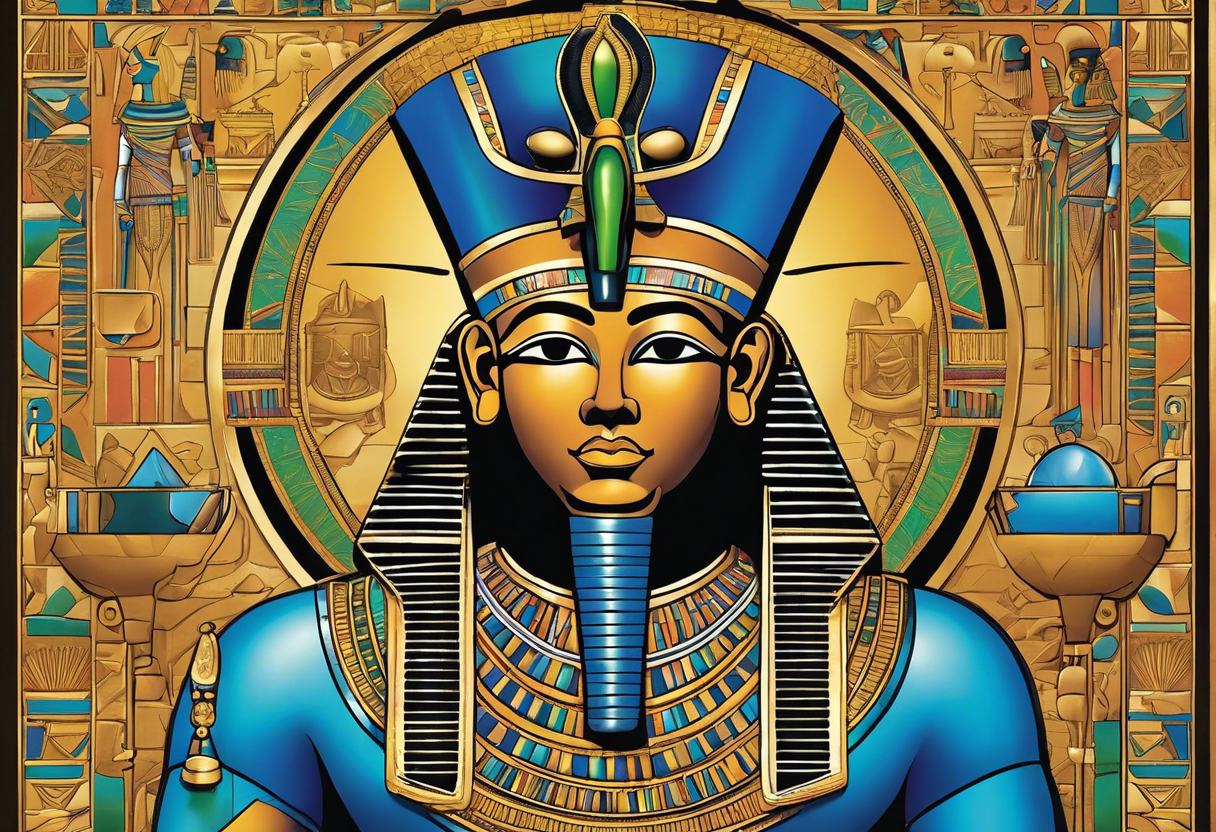
Osiris, the ancient Egyptian god of life, death, and rebirth, played a pivotal role in ancient Egyptian society. He held a prominent position among the pantheon of gods and exerted a profound influence on various aspects of Egyptian society, including religion, government, and the afterlife.
Religious Significance
Osiris was considered the chief god of the underworld and the judge of the dead. He presided over the judgment of the souls in the Hall of Ma'at, where the hearts of the deceased were weighed against the feather of truth. This aspect of Osiris' role in the journey to the afterlife instilled a sense of morality and justice in Egyptian society, as individuals believed that their actions during their lifetime would determine their fate in the afterlife.
Furthermore, Osiris was associated with fertility and agriculture. As the god of the Nile, his annual death and resurrection symbolized the cycle of life, death, and rebirth, mirroring the flooding and receding of the Nile River, which was essential for the agricultural prosperity of ancient Egypt. This connection to fertility made Osiris a widely worshipped deity among the Egyptian people, as they relied heavily on agricultural practices for their sustenance.
Sociopolitical Influence
The Osirian cult, centered around the worship of Osiris, gained immense popularity and political significance in ancient Egyptian society. The pharaohs of the Middle and New Kingdoms identified themselves with Osiris, as they sought to ensure their own resurrection and eternal rule in the afterlife. This association with Osiris not only solidified their divine authority but also strengthened their position as the religious and political leaders of Egypt.
Moreover, Osiris was venerated not only by the ruling elite but also by the common people. His teachings of morality, righteousness, and a just afterlife greatly influenced Egyptian society, shaping the ethical standards and social values of the time. The belief in Osiris' power to grant eternal life and provide justice created a sense of social cohesion and harmony among the Egyptian people.
Funerary Practices and Rituals
Osiris' role in the afterlife had a significant impact on the funerary practices and rituals of ancient Egypt. The Egyptians believed in the necessity of preserving the body through mummification to ensure a successful journey to the afterlife. The rituals and ceremonies associated with death, such as the Opening of the Mouth ceremony, were conducted with the hope of appeasing Osiris and securing the deceased's place in the afterlife.
Osiris' symbolism and rituals extended beyond the royal burials and encompassed funerary practices for all Egyptians. The Book of the Dead, a collection of spells and incantations, was a crucial guide for ensuring a safe passage through the underworld, with Osiris as the ultimate guarantor of the deceased's rebirth and eternal existence.
In conclusion, Osiris held a central role in ancient Egyptian society. As the god of life, death, and rebirth, his religious significance, sociopolitical influence, and impact on funerary practices shaped various aspects of Egyptian culture. The worship of Osiris provided the Egyptian people with a moral compass, a sense of national identity, and the hope for a just afterlife, making him one of the most revered and impactful deities of ancient Egypt.
The Myth of Osiris and Isis

The myth of Osiris and Isis is one of the most well-known and enduring stories in ancient Egyptian mythology. It tells the tale of two powerful deities who rule over Egypt and the challenges they face in maintaining their divine power.
According to the myth, Osiris is the ruler of Egypt, a wise and just pharaoh who brings prosperity and harmony to the land. He is married to his sister Isis, who is not only his wife but also his equal in power and wisdom. Together, they create a golden age for Egypt, bringing peace and abundance to their people.
However, their happiness is short-lived when Osiris's jealous brother Set, the god of chaos and violence, plots to overthrow him and seize the throne for himself. Set tricks Osiris into entering a beautifully crafted coffin and then seals it shut, throwing it into the Nile River. Osiris drowns, and his body is carried away by the river's currents.
Devastated by her husband's tragic fate, Isis embarks on a quest to find and restore Osiris. Through her magical powers and determination, she eventually discovers his body trapped in a tamarisk tree that grew around it. With the help of the god Thoth, she resurrects Osiris and together they conceive their son Horus.
This myth serves as an allegory for the cycle of life, death, and rebirth. Osiris represents the life force that sustains the land of Egypt, and the annual flooding of the Nile River, which brings fertility to the soil. His death and resurrection symbolize the agricultural cycle, where crops die during the dry season but are reborn with the return of the annual flood.
Moreover, the story highlights the importance of balance and harmony in Egyptian society. Osiris embodies the ideal ruler, bringing order and prosperity to the land, while Isis represents the power of femininity and nurturing. Their union exemplifies the necessary balance between male and female energies in maintaining a just and prosperous society.
The myth of Osiris and Isis also emphasizes the power of love and devotion. Isis's unwavering love for her husband drives her to search for him endlessly and to overcome every obstacle in her path. Her determination and magical abilities demonstrate the strength of a committed and loving partnership.
Overall, the myth of Osiris and Isis holds significant cultural and religious significance in ancient Egyptian society. It conveys important lessons about the cycle of life and the importance of balance and love in maintaining a harmonious society. This enduring story continues to captivate the imagination and inspire awe in people today, reflecting the timeless power of ancient Egyptian mythology.
The Osiris Myth and the Afterlife Beliefs
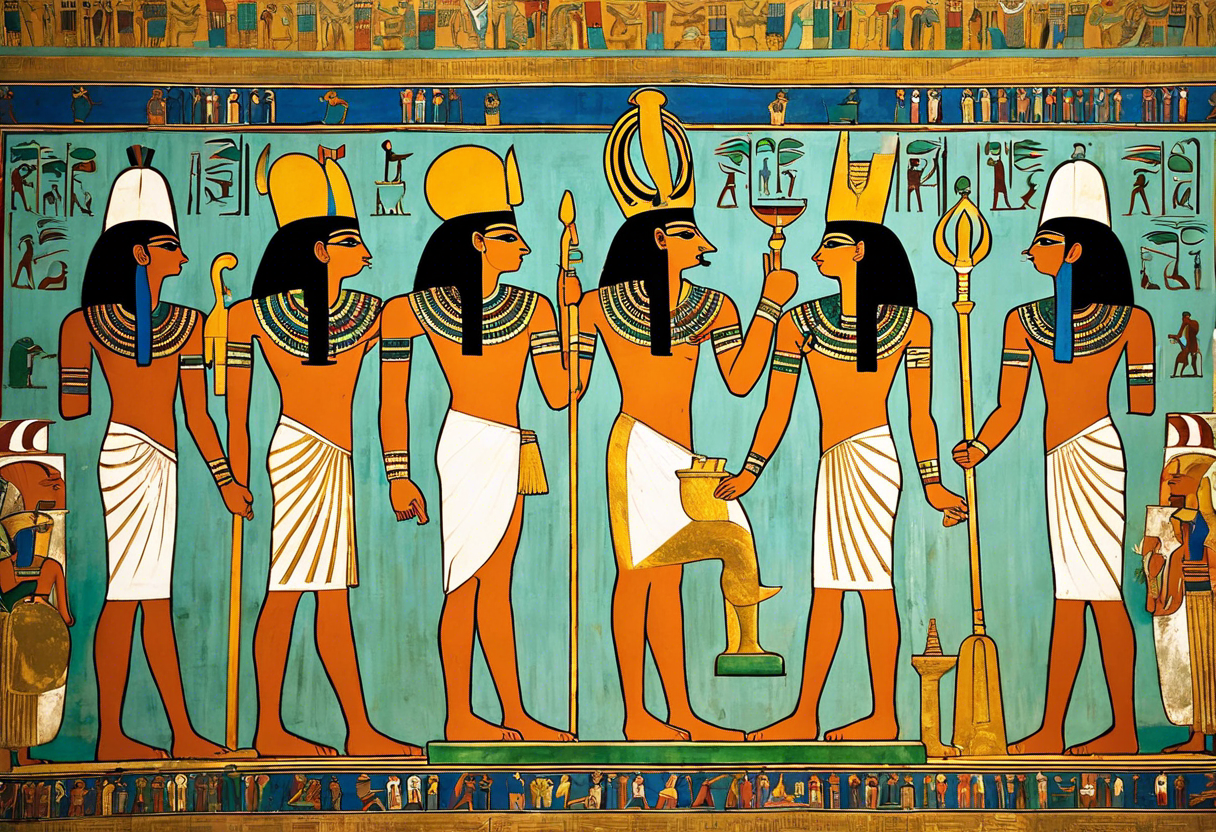
The Osiris myth is a crucial aspect of ancient Egyptian mythology and plays a significant role in their beliefs about the afterlife. It tells the story of Osiris, the god of the underworld and the judge of the dead, and his journey into the afterlife. This myth was central to Egyptian funerary practices and shaped their beliefs and rituals surrounding death.
According to the myth, Osiris was initially a wise and benevolent king who ruled over Egypt. However, his jealous brother Set desired the throne and plotted against him. Set tricked and killed Osiris, dismembering his body and scattering it across Egypt. Despite this gruesome act, Osiris' sister and wife, Isis, managed to gather his scattered remains and resurrect him temporarily, allowing him to conceive their son Horus.
The story of Osiris encompasses themes of death, resurrection, and the triumph of good over evil. It emphasizes the cyclical nature of life and the eternal nature of the soul. The concept of resurrection and the journey to the afterlife were crucial elements in the ancient Egyptians' beliefs. They believed that after death, the deceased would face a judgment before Osiris, where their hearts would be weighed against the Ma'at, the goddess of truth and justice. If their hearts were pure and lighter than the feather of Ma'at, they would be granted eternal life in the afterlife; if not, they would be condemned to non-existence.
To ensure a successful afterlife, the ancient Egyptians engaged in elaborate rituals and preparations. They believed that the deceased needed to be properly preserved through a process called mummification to prevent their bodies from decaying. They also provided them with food, clothing, and other items they might need in the afterlife, which were buried with them in their tombs.
The Osiris myth and the belief in the afterlife greatly influenced Egyptian funerary rituals and the construction of tombs and pyramids. These monumental structures served as the final resting places for pharaohs and other high-ranking individuals, mimicking the journey of Osiris and symbolizing their eternal life.
The Osiris myth and the associated beliefs about the afterlife played a significant role in shaping the culture and religious practices of ancient Egypt. They provided the basis for the complex funerary rituals and the construction of elaborate tombs, demonstrating the importance of the afterlife in the lives of the ancient Egyptians. The myth served as a source of comfort and hope, assuring individuals that death was not the end but rather the beginning of a new journey towards eternal life.
Festivals and Rituals Dedicated to Osiris
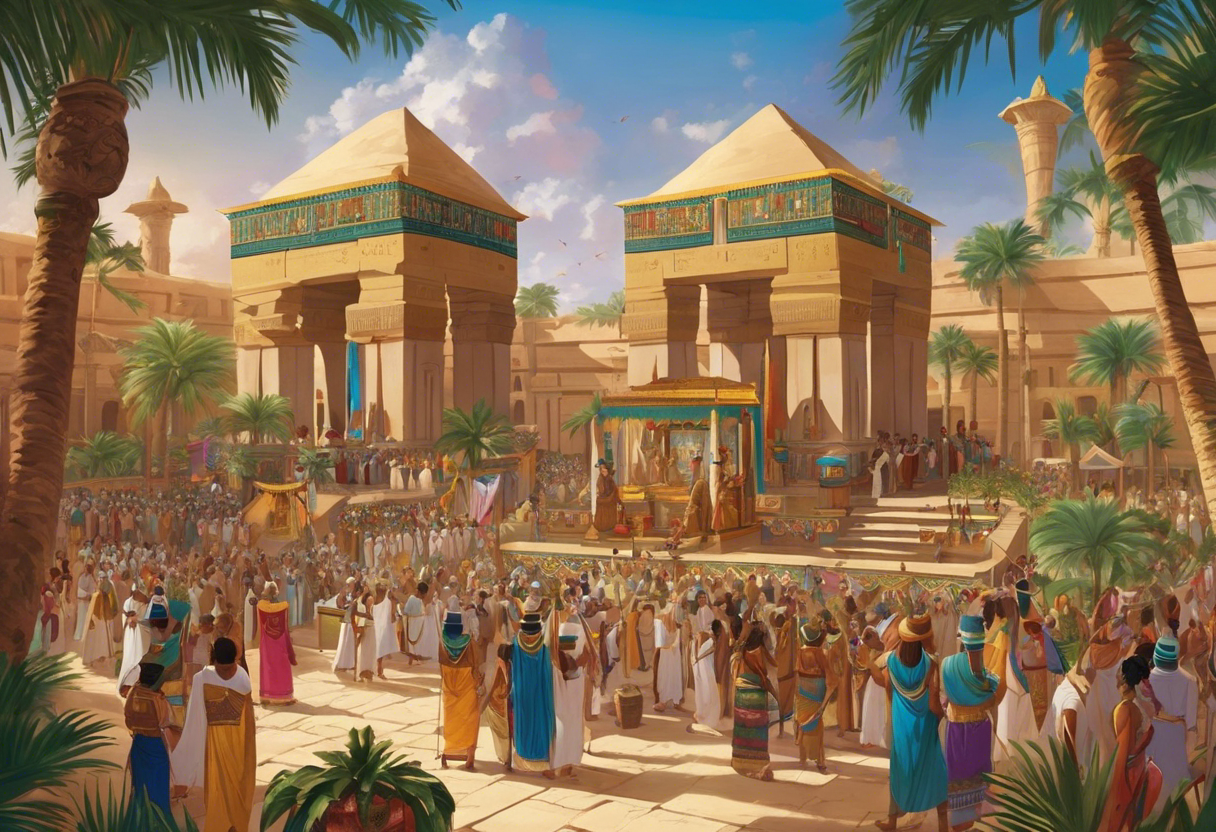
Osiris, being one of the most revered gods in ancient Egypt, was honored through various festivals and rituals conducted throughout the year. These celebrations played a significant role in the religious life of the Egyptians and offered devotees the opportunity to demonstrate their devotion and seek the blessings of Osiris.
One of the most notable festivals dedicated to Osiris was the "Festival of Osiris" or "Abydos festival." This annual event, usually held in Abydos, the cult center of Osiris, involved elaborate ceremonies and processions. People from all over Egypt would gather to pay homage to Osiris, celebrate his life, and seek his guidance. The festival was a time of joy and reverence, with religious rituals, music, dances, and offerings of food and drink. It was believed that participating in this festival granted protection, prosperity, and salvation from the god.
Another significant celebration associated with Osiris was the "Osiris Mysteries," a sacred and secretive ritual held in the city of Busiris. Only initiates were allowed to participate in these mysteries, which involved reenacting the myth of Osiris' death and resurrection. The ceremonies were believed to bring about spiritual enlightenment and ensure the eternal life of the participants.
Additionally, Osiris was revered during the "Festival of Sokar" which took place in Memphis. This festival commemorated the journey of Osiris to the Netherworld and honored him as the ruler of the afterlife. People would join solemn processions, offer prayers, and make rituals in front of statues and shrines dedicated to Osiris. The festival aimed to ensure the renewal of life and bring hope for the deceased to pass safely into the afterlife.
In the religious calendar of ancient Egypt, there were also specific dates and rituals dedicated to the worship of Osiris. For instance, on the 17th day of the first month of the Egyptian lunar calendar, known as "The Feast of Osiris," people would offer offerings of fruits, vegetables, and flowers to the god. This celebration symbolized the resurrection and renewal of Osiris, reflecting the eternal cycle of life and death.
Overall, the festivals and rituals dedicated to Osiris were vital aspects of ancient Egyptian religious practices. They provided devotees with the opportunity to express their devotion, seek blessings, and connect with the divine realm. Through these celebrations, the ancient Egyptians honored Osiris as the powerful and benevolent god who offered hope for the afterlife and the promise of eternal existence.
The Iconography of Osiris
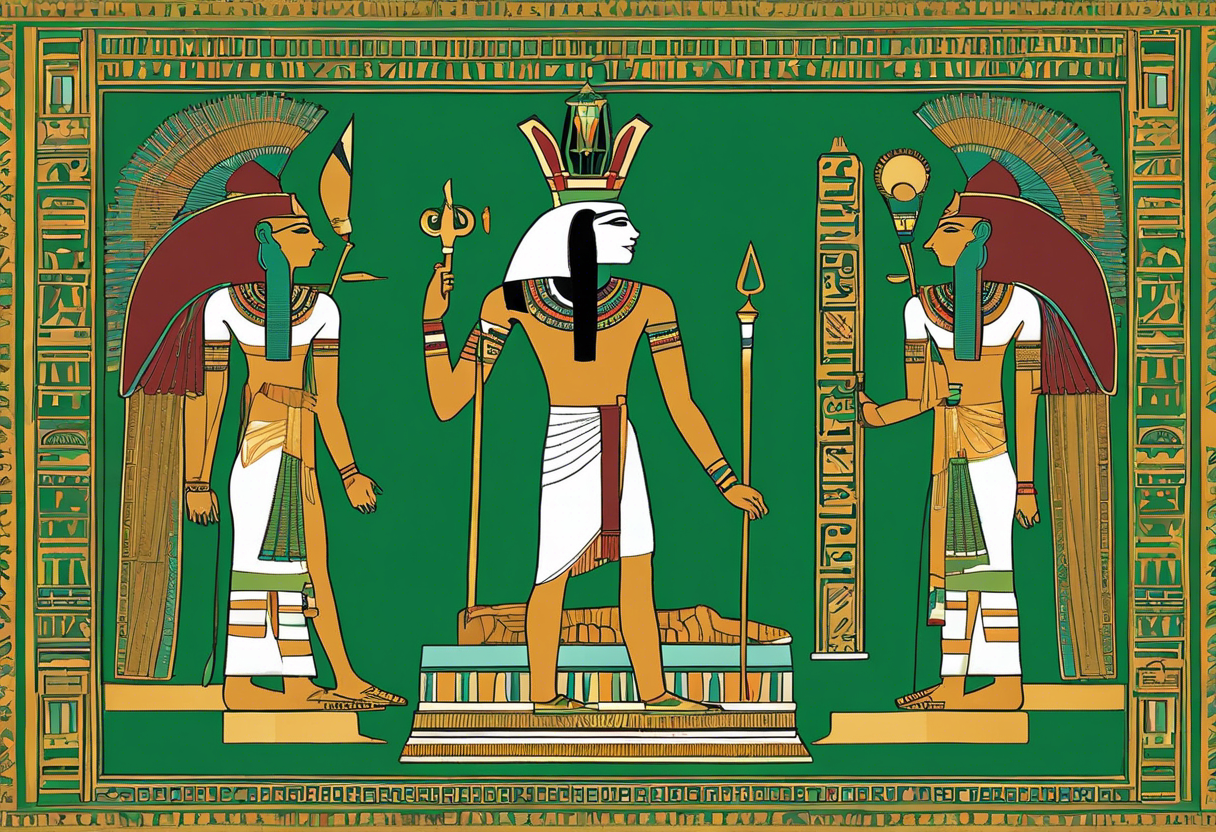
The iconography of Osiris, the ancient Egyptian god, provides valuable insights into his role and significance in Egyptian mythology. The portrayal of Osiris in art and architecture reflects the deep reverence and importance attributed to him in ancient Egyptian society.
Depictions of Osiris
Mummiform Representation: One common depiction of Osiris is as a mummified figure, wrapped in linen bandages. This representation emphasizes his role as the god of the afterlife and the judge of the dead. The mummiform depiction also symbolizes the cycle of death and rebirth, as Osiris was believed to have been resurrected after his murder by his brother Seth.
Crook and Flail: Osiris is often depicted holding a crook and flail in his hands. The crook represents his role as a shepherd of souls and a protector of the righteous. The flail, on the other hand, symbolizes his authority and power as a king.
Atef Crown: Osiris is frequently shown wearing the atef crown, a tall white crown adorned with ostrich feathers and a sun disk. This crown symbolizes his sovereignty and divine authority, connecting him to the solar deity Ra. It represents Osiris's role as the ruler of the underworld and the afterlife.
Symbolism and Meaning
The iconography of Osiris carries rich symbolism and conveys important aspects of his mythological significance. The mummiform representation emphasizes his role as the judge of the dead and the guardian of the afterlife. It also embodies the concept of death and resurrection, reflecting the cyclical nature of existence in Egyptian beliefs.
The crook and flail held by Osiris communicate his qualities as a wise shepherd and a just ruler. The crook represents his care for the souls of the deceased, guiding them to their rightful place in the afterlife. The flail exemplifies his authority and power, highlighting his role as a benevolent king.
The atef crown worn by Osiris signifies his royal sovereignty and his association with the sun god Ra. It symbolizes his rule over the realm of the dead, emphasizing his divine authority and power in the afterlife.
Variation in Depictions
It is important to note that the iconography of Osiris can vary in different periods and contexts of ancient Egyptian art. Various artistic styles and regional variations can be seen in the depiction of Osiris, reflecting the evolving beliefs and cultural influences within ancient Egypt.
Overall, the iconography of Osiris plays a significant role in capturing the essence of this revered deity in Egyptian mythology. Through these visual representations, the ancient Egyptians revered and honored Osiris as the god of the afterlife, the ruler of the underworld, and the ultimate judge of the dead.
Osiris in Modern Culture
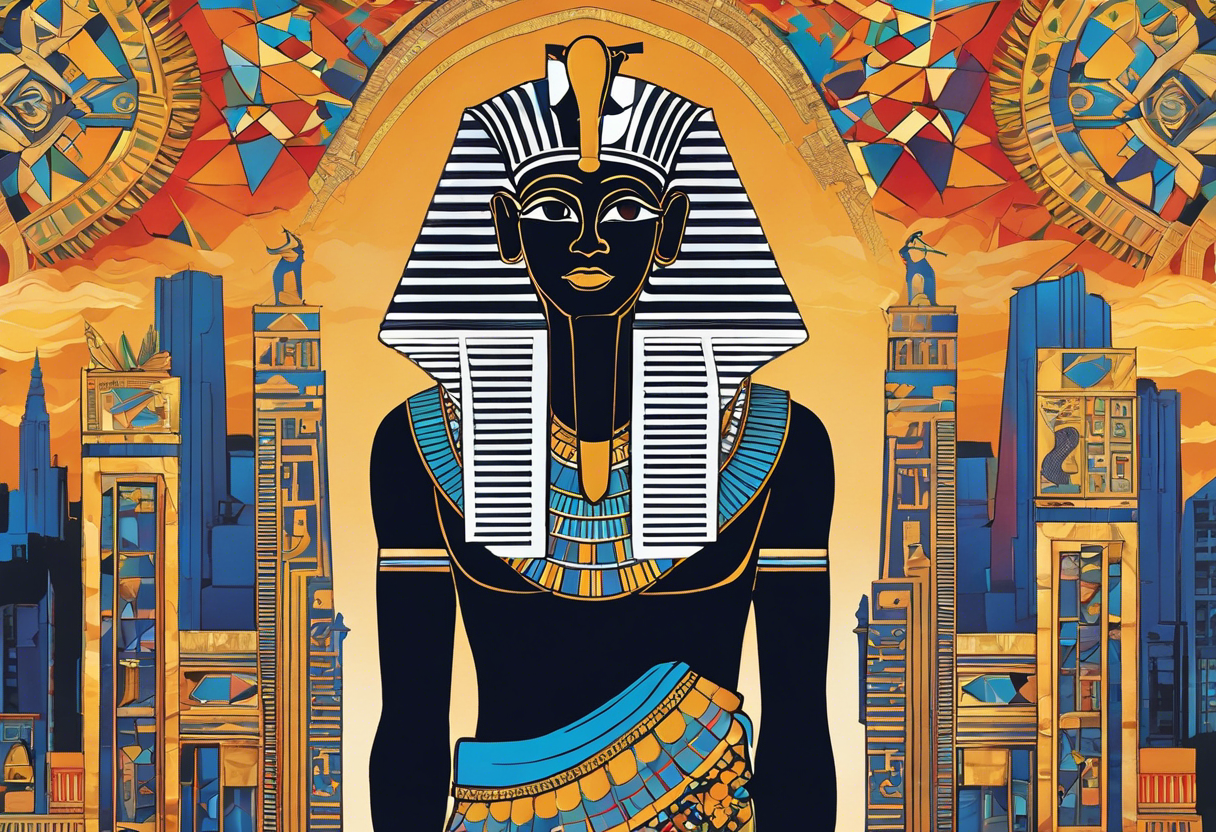
Despite being an ancient deity, the influence of Osiris can still be felt in modern culture. His compelling story and symbolic significance have inspired various forms of artistic expression, literature, and even popular entertainment. Here are some notable examples of Osiris's presence in modern culture:
1. Literature and Art
Osiris has been a popular subject for artists and writers alike. His story has been retold and reimagined in countless books, poems, and plays, allowing audiences to explore the themes of death, resurrection, and the afterlife. Artists have also used Osiris as a muse, portraying him in paintings and sculptures that capture the majesty and mystery surrounding the ancient Egyptian god.
2. Film and Television
The influence of Osiris can also be seen in modern film and television. Various movies and TV shows have drawn inspiration from Egyptian mythology, often featuring references to Osiris and his iconic attributes. These appearances serve to evoke a sense of mysticism and ancient wisdom, adding depth and intrigue to the narratives being told.
3. Popular Culture References
Osiris has made his way into popular culture in various ways. His name, symbol, or likeness can be found in video games, comic books, and even in naming conventions for businesses and products. These references not only showcase the enduring power of ancient Egyptian mythology but also serve as a reminder of Osiris's significance as a cultural icon.
4. Music and Dance
Osiris has also found a place in the world of music and dance. Musicians and performers have been inspired by Osiris's story, incorporating elements from ancient Egyptian culture into their music videos, stage productions, and performances. These artistic interpretations help to keep the legacy of Osiris alive and introduce his mythology to new audiences.
5. Spiritual Practices
In addition to artistic and entertainment mediums, Osiris's influence can also be seen in modern spiritual practices. Some individuals have turned to ancient Egyptian beliefs and rituals, incorporating aspects of Osiris worship into their own spiritual journeys. This illustrates the enduring appeal and relevance of Osiris's story as a source of inspiration and guidance.
As Osiris continues to captivate the imagination of people around the world, his presence in modern culture serves as a testament to the enduring power and beauty of ancient Egyptian mythology. Through various forms of artistic expression and cultural references, Osiris remains a symbol of life, death, and rebirth, reminding us of the timeless themes that connect humanity across the ages.
The Legacy of Osiris in Egyptian History
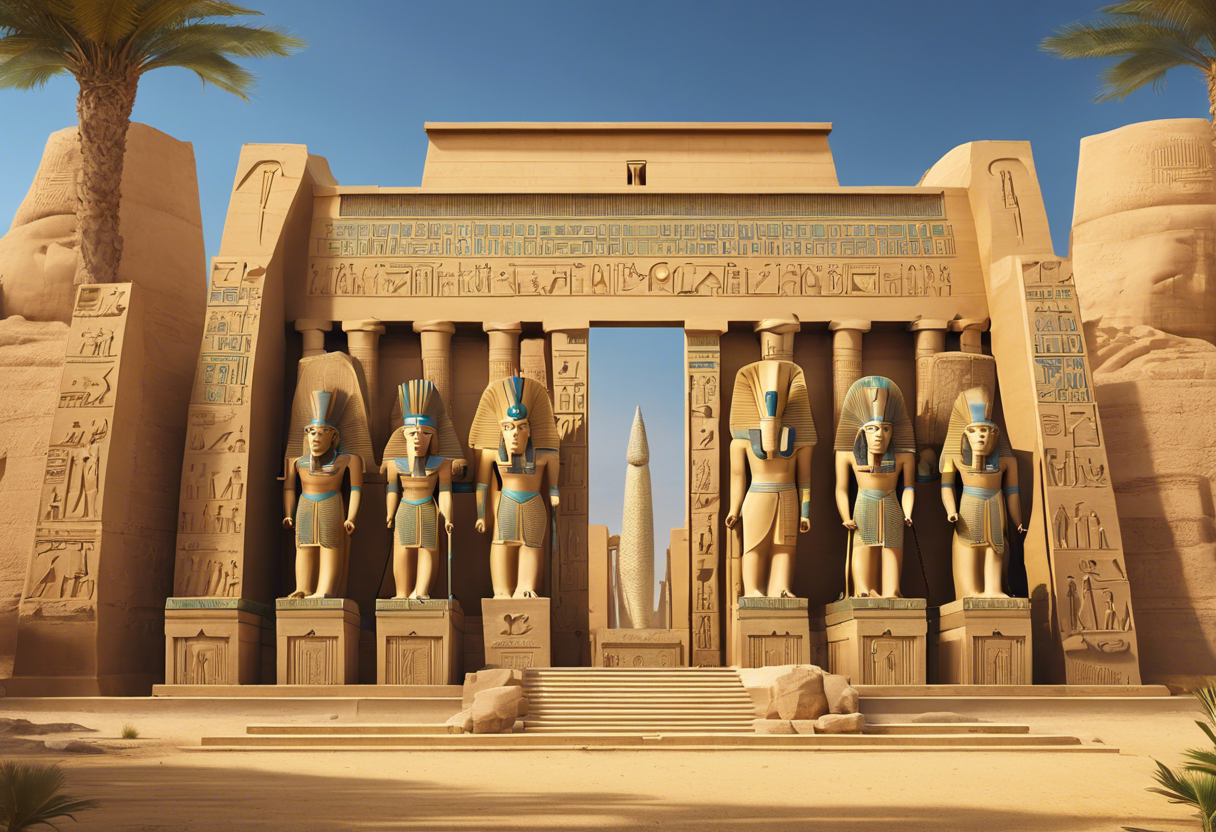
The god Osiris holds a significant place in the mythology and history of ancient Egypt. Throughout the centuries, Osiris became one of the most prominent deities in Egyptian religion, leaving a lasting legacy that influenced various aspects of Egyptian culture and society. Here, we delve into the profound impact of Osiris in Egyptian history.
Symbol of Resurrection and the Afterlife
Osiris is primarily known as the god of the afterlife and the judge of souls. Ancient Egyptians believed in an afterlife governed by Osiris, where the deceased would undergo judgment based on their earthly deeds. Those deemed righteous would be granted eternal life, while the wicked would face punishment. This concept of judgment and the idea of being resurrected in the afterlife played a crucial role in Egyptian funerary practices and beliefs.
Foundation of Kingship
Osiris' story also played a significant role in the establishment of the pharaoh's divine authority in ancient Egypt. According to myth, Osiris was the first pharaoh, ruling over Egypt with wisdom and justice. His murder by his brother Seth and subsequent resurrection symbolized the eternal cycle of life, death, and rebirth, and served as a model for pharaohs who followed. The pharaohs identified themselves with Osiris, believing that they would be united with him in the afterlife.
Agricultural Symbolism
Osiris was closely associated with fertility and agricultural abundance. As the god of the Nile flood, which played a vital role in the fertility of the land, Osiris represented the cyclical nature of agricultural life. The myth of his death and resurrection paralleled the agricultural seasons, symbolizing the death of crops in the dry season and their rebirth with the floodwaters.
Influence on Mythology and Iconography
The mythology surrounding Osiris had a profound impact on the overall Egyptian religious belief system. His story of death and resurrection influenced several other myths and rituals associated with different gods and goddesses. Moreover, Osiris' iconic portrayal as a mummified deity, wrapped in linen bandages, became a common motif in Egyptian art and funerary practices. This imagery served to reinforce the belief in resurrection and the afterlife.
Enduring Significance and Cultural Influence
Osiris' influence and significance were not confined to ancient Egypt alone. As Egyptian civilization extended its reach, so too did the worship and understanding of Osiris. His myths and beliefs spread throughout the Mediterranean world, influencing the religious practices of other civilizations. Furthermore, the concept of judgment, resurrection, and the afterlife associated with Osiris had a profound impact on later religious traditions, including Christianity and its belief in the resurrection of Jesus Christ.
In conclusion, Osiris, the ancient Egyptian god of the afterlife, played a crucial role in Egyptian history, culture, and religion. From being a symbol of resurrection and the afterlife to the foundation of kingship and agricultural symbolism, Osiris left an enduring legacy that influenced Egyptian mythology, iconography, and even later religious traditions. Today, the myth of Osiris continues to captivate the imagination, reflecting the timeless fascination with life, death, and the possibility of rebirth.
Conclusion: Osiris, the Eternal Symbol of Resurrection and Renewal
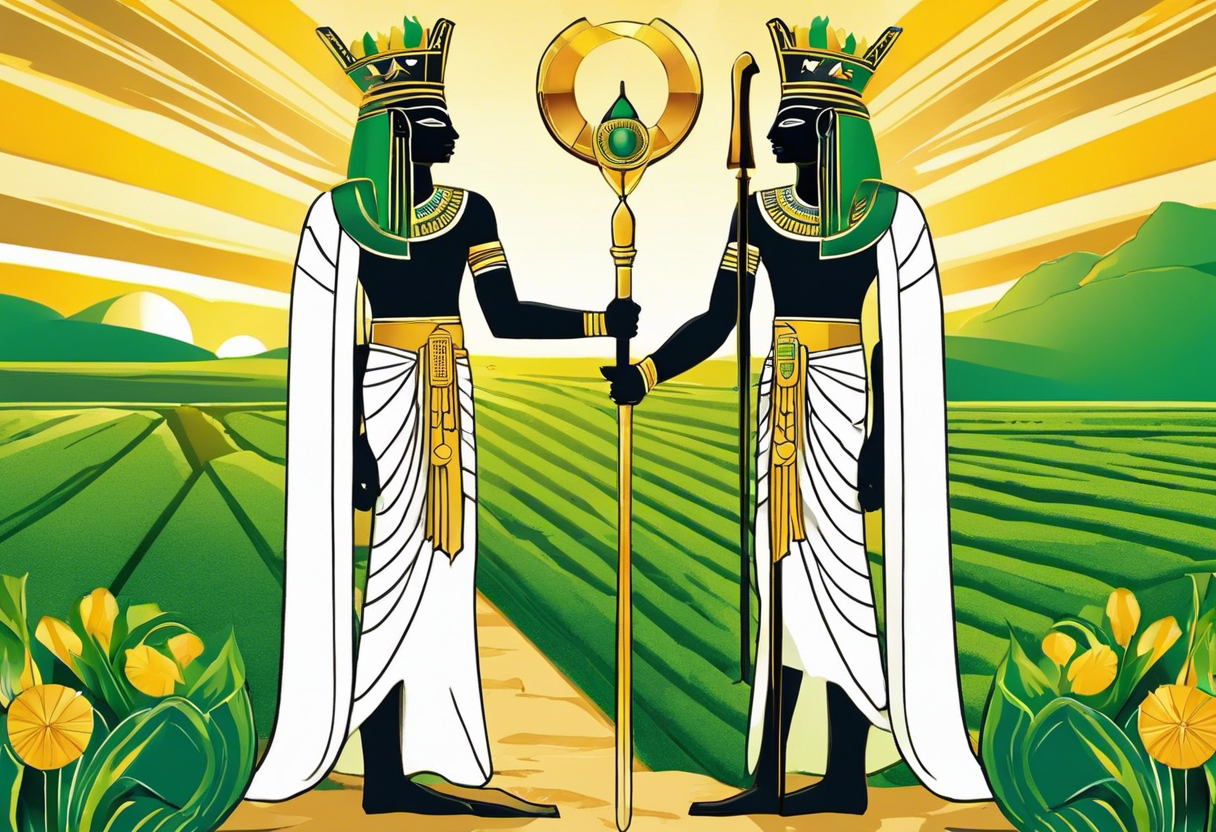
Throughout ancient Egyptian mythology, Osiris held a significant role as the god of the afterlife, rebirth, and fertility. His story, filled with intricate details and symbolism, has captured the imagination of people for centuries. As we have explored his mythological journey, it becomes clear that Osiris represents important concepts such as resurrection, renewal, and the cycle of life.
One of the key symbols associated with Osiris is his role as the judge of the dead. Being the ruler of the underworld, he would weigh the hearts of the deceased against the feather of Ma'at, representing truth and justice. This depiction highlights Osiris' role as a guiding force in the afterlife, ensuring that the souls of the departed are granted eternal peace and harmony.
Another significant aspect of Osiris' mythology is his association with rebirth. His murder and subsequent resurrection by his sister-wife Isis demonstrates the cyclical nature of life and death. Osiris' death represents the natural decay and decline that is followed by his triumphant rebirth, symbolizing the eternal cycle of nature.
Osiris is also closely linked to the concept of fertility, as he was believed to be responsible for the annual flooding of the Nile River. This inundation, essential for agriculture and sustenance, was seen as a sign of Osiris' life-giving power and the renewal it brought to the land. The connection between Osiris and fertility highlighted the importance of his role in ensuring the prosperity and abundance of the Egyptian people.
Furthermore, Osiris' story serves as a model for personal transformation and spiritual growth. His death and resurrection represent the trials and challenges that individuals face in their own lives. It is through these hardships that one can find the strength to overcome obstacles, evolve, and experience a personal rebirth akin to Osiris' resurrection.
In conclusion, Osiris is an enduring symbol of resurrection and renewal in ancient Egyptian mythology. His story, filled with intricate symbolism and profound themes, continues to captivate and inspire people today. Osiris reminds us of the cyclical nature of life, the importance of justice and truth, and the potential for personal transformation. By delving into the mythology of Osiris, we gain insight into the rich spiritual beliefs of the ancient Egyptians and find deeper meaning in our own lives.
